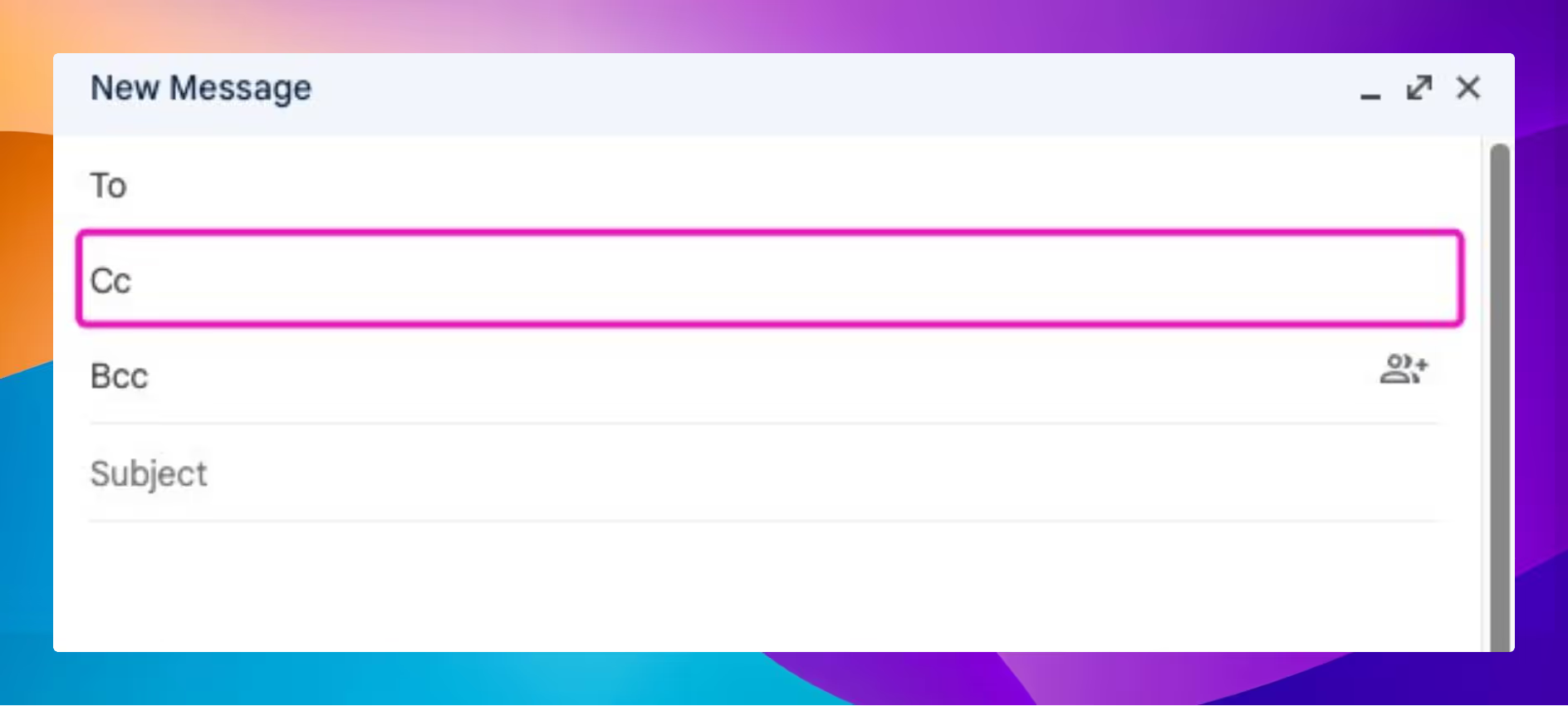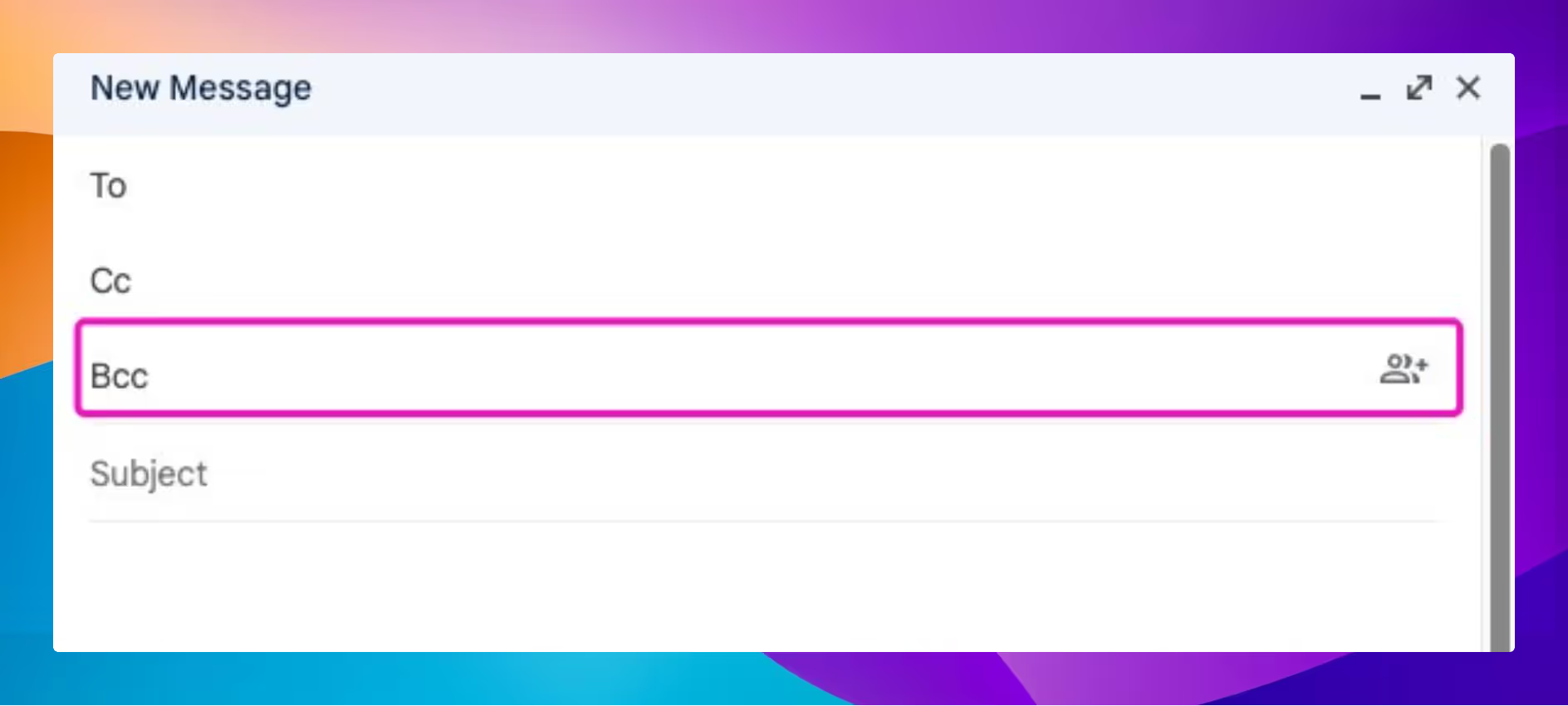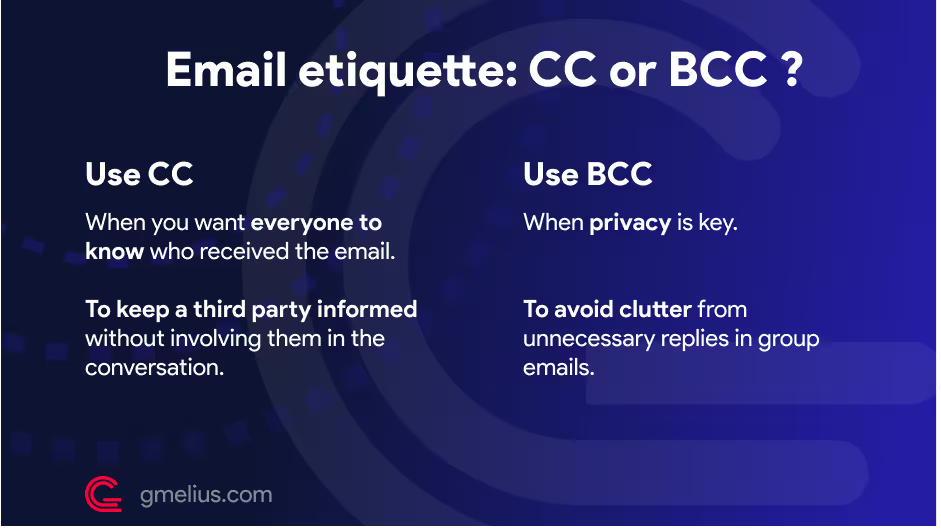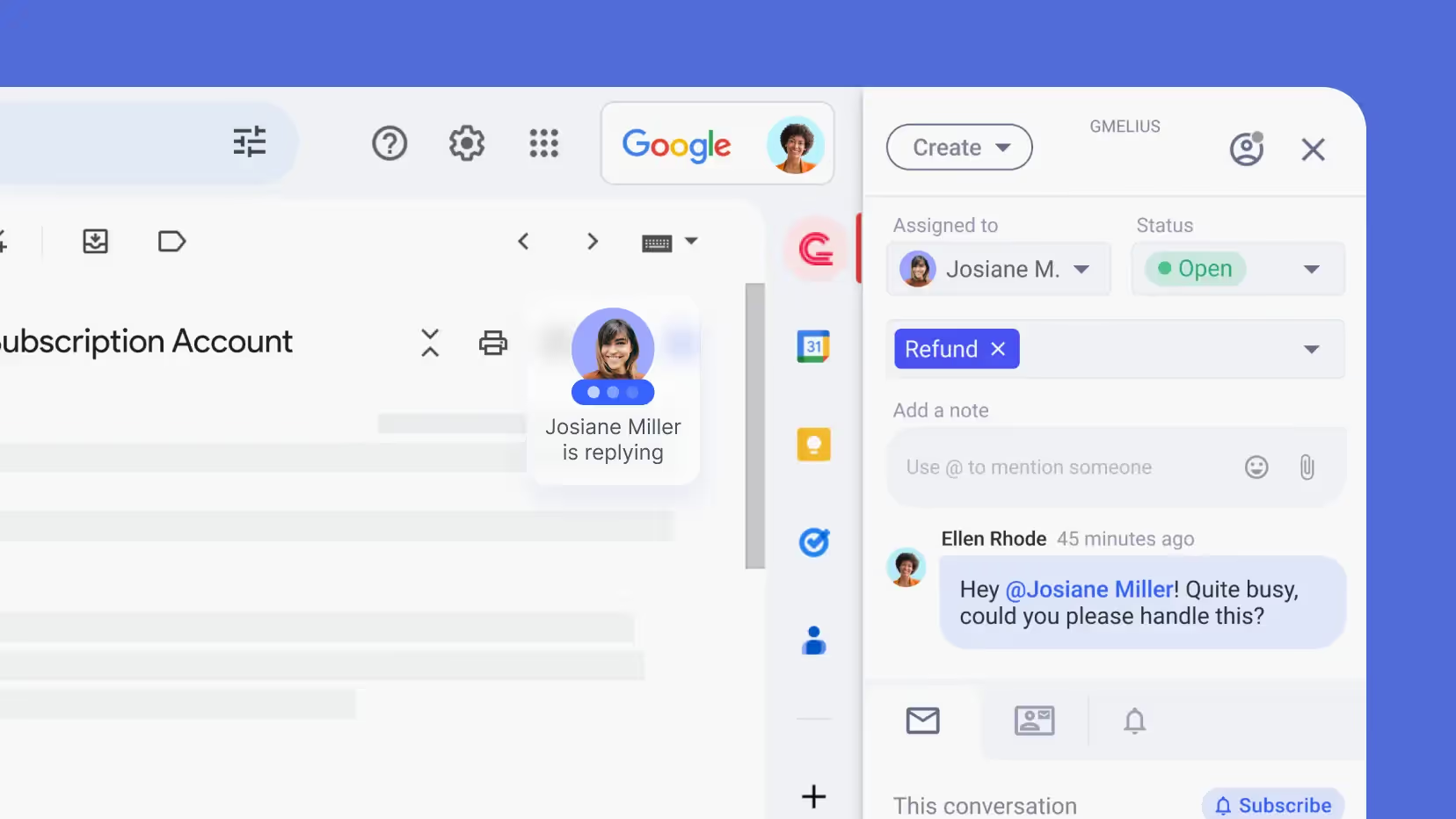Que signifient CC et BCC dans les e-mails ?
Le courrier électronique est un outil essentiel pour la communication personnelle et professionnelle. Lorsque vous rédigez un e-mail, vous remarquerez peut-être les champs « CC » et « BCC ». Ces champs ont des objectifs différents et sont importants à comprendre pour une communication efficace et une étiquette en matière de courrier électronique.
Le champ « BCC » se trouve généralement sous le champ « CC » dans la plupart des clients de messagerie. Il vous permet d'ajouter des destinataires sans révéler leurs adresses aux autres. Savoir comment et quand utiliser ces champs permet de garantir une communication claire et appropriée.
Cet article explique ce que signifient CC et BCC dans les e-mails, met en évidence leurs différences et fournit les meilleures pratiques pour les utiliser. Alors que les destinataires CC sont visibles par tous, les destinataires BCC restent masqués, ce qui rend le choix entre eux crucial pour la transparence et la confidentialité.
Êtes-vous prêt à améliorer la gestion de vos e-mails ? Essayez Gmelius!
Que signifie CC dans un e-mail ?

CC représente Copie carbone.
Le terme vient de l'ère des machines à écrire, où le papier carbone était utilisé pour faire des doublons. Dans les e-mails, le champ CC vous permet d'envoyer une copie de votre e-mail à d'autres destinataires. Toutes les personnes répertoriées dans le champ CC reçoivent l'e-mail et peuvent voir qui d'autre a été codé.
Comment fonctionne CC dans les e-mails
Lorsque vous indiquez une adresse e-mail dans le champ CC, le destinataire reçoit une copie de l'e-mail. Contrairement à ceux qui figurent dans le champ « À », les bénéficiaires du CC ne constituent pas le public principal mais sont inclus pour rester informés. La principale caractéristique de CC est la transparence : tout le monde dans le champ CC peut voir tous les autres destinataires. Il est essentiel de comprendre comment utiliser à la fois le CC et le BCC : CC est pour la transparence, tandis que le BCC est pour la confidentialité.
Définition et cas courants de CC
Lorsque vous cédez une copie de quelqu'un, vous dites essentiellement : « Je vous tiens au courant, mais aucune action n'est requise de votre part ». Voici quelques scénarios typiques :
- Tenir les parties prenantes informées: envoyez à votre responsable ou chef d'équipe des e-mails pertinents pour le tenir au courant de l'avancement du projet.
- Maintien de la transparence: utilisez CC pour que tout le monde soit au courant des mises à jour du projet ou des décisions de groupe.
- Etiquette professionnelle: Dans les environnements formels, CC permet de documenter la communication avec plusieurs parties.
Que signifie BCC dans un e-mail ?

BCC représente Copie carbone à l'aveugle.
Comme CC, il repose sur le concept de copie carbone mais met l'accent sur la confidentialité.
Comment fonctionne le BCC dans les e-mails
Lorsque vous utilisez le champ BCC pour ajouter des destinataires, ceux-ci reçoivent l'e-mail exactement comme ceux des champs « À » et « CC ». Cependant, la principale différence est que les destinataires dans le champ BCC sont cachés à tout le monde.
La fonction BCC est utile pour préserver la confidentialité des destinataires dans e-mails de groupe et en évitant l'encombrement des réponses à toutes les questions. Les autres destinataires ne peuvent pas voir qui figure sur la liste BCC, ce qui fait de BCC un outil puissant pour préserver la confidentialité des communications par e-mail. Pour s'assurer que l'e-mail peut être envoyé lorsque vous utilisez BCC, il est nécessaire d'inclure une adresse e-mail dans le champ « À » ; l'utilisation de sa propre adresse e-mail est une solution de contournement courante.
Signification de BCC et cas d'utilisation courants
Le BCC est utile pour préserver la confidentialité des informations des destinataires ou empêcher les situations indésirables de type « Répondre à tous ». Cependant, une mauvaise utilisation peut entraîner des problèmes de transparence ou des malentendus si une personne du BCC répond à toutes les questions. Les scénarios courants pour le BCC incluent :
- Protection de la vie privée: utilisez BCC dans les e-mails de masse, tels que les newsletters, afin de préserver la confidentialité des adresses e-mail.
- Empêcher les chaînes Reply-All: Dans les grands groupes, le BCC empêche un flot de réponses.
- Marketing par e-mail: Le BCC est couramment utilisé pour protéger les listes de destinataires dans les e-mails marketing.
CC et BCC — Principales différences
Connaître les différences entre CC et BCC est important pour une utilisation correcte du courrier électronique. En voici le détail :
Visibilité
CC: les destinataires peuvent voir toutes les autres copies de l'e-mail.
BCC: les destinataires sont cachés les uns des autres, ce qui garantit la confidentialité.
Finalité
CC: Pour plus de transparence et pour tenir les autres informés.
BCC: Pour des raisons de confidentialité et pour éviter les chaînes de réponses.
Attentes de réponse
CC: Les bénéficiaires peuvent avoir l'impression d'être tenus de répondre, en particulier dans un contexte professionnel.
BCC: Les destinataires ne sont généralement pas tenus de répondre.
Etiquette des e-mails : quand utiliser CC ou BCC
CC: À utiliser lorsque vous souhaitez tenir quelqu'un informé sans demander de réponse. Par exemple, informer les parties prenantes qui n'ont pas besoin d'agir sur la base des informations.
BCC: à utiliser lors de l'envoi d'e-mails à de grands groupes pour protéger la confidentialité, par exemple dans le cadre d'un e-mail de masse ou pour éviter des réponses inutiles.
Voici une comparaison rapide :
Meilleures pratiques pour utiliser CC et BCC dans les e-mails

Utilisez CC :
- Lorsque vous voulez que tout le monde sache qui a reçu l'e-mail.
- Tenir un tiers informé sans l'impliquer dans la conversation.
Utilisez BCC :
- Quand la confidentialité est essentielle.
- Pour éviter l'encombrement dû aux réponses inutiles dans les e-mails de groupe.
⚠️ Éviter les pièges courants ⚠️
- Utilisation excessive de CC : Le fait de contacter trop de personnes peut entraîner une surcharge de courriels et de la frustration.
- Exposition accidentelle de courriers électroniques : L'utilisation de CC au lieu de BCC dans les e-mails de masse peut exposer les e-mails des destinataires, ce qui entraîne des problèmes de confidentialité. Les destinataires du BCC ne peuvent pas voir les noms ou adresses des autres destinataires du BCC.
💡 Conseils relatifs à l'étiquette des e-mails 💡
- Soyez sélectif: N'incluez que les personnes qui ont besoin de l'information.
- Lignes d'objet claires: Indiquez clairement l'objectif de l'e-mail dès le départ.
- Gardez les e-mails concis: les e-mails courts permettent d'éviter de manquer des informations.
Avantages d'une utilisation correcte du CC et du BCC
L'utilisation correcte du CC et du BCC peut présenter plusieurs avantages :
- Communication améliorée: Informe tout le monde sans le surcharger.
- Productivité améliorée: Réduit les réponses inutiles et le temps de gestion des e-mails.
- Confidentialité et sécurité: protège les informations sensibles contre toute exposition.
Scénarios du monde réel
Exemple professionnel — CC : Envoyer une mise à jour du projet à votre équipe et contacter votre responsable pour le tenir informé.
Objet : Mise à jour de Project X
CC : [E-mail du responsable]
Bonjour l'équipe,
Voici une brève mise à jour sur Project X...
Meilleur,
[Votre nom]
Exemple professionnel — BCC : Envoi d'une newsletter client à un grand groupe et utilisation de BCC pour préserver la confidentialité des adresses e-mail. L'utilisation du BCC dans les e-mails marketing est cruciale pour préserver la confidentialité lors de la distribution d'e-mails à plusieurs destinataires. Ceci est particulièrement important lors de l'envoi de newsletters, de mises à jour de la marque et de promotions. L'utilisation appropriée du BCC garantit le respect de l'étiquette en matière de courrier électronique et permet d'éviter les implications juridiques potentielles liées à la gestion des adresses e-mail des destinataires.
Objet : Bulletin mensuel — édition de septembre
BCC : [Liste des bénéficiaires]
Bonjour à tous,
Nous sommes ravis de partager les dernières mises à jour...
Bravo,
[Votre nom]
Quelles sont vos options au lieu de CC et BCC dans les e-mails ?
Bien que CC et BCC proposent différentes manières d'ajouter des personnes à un e-mail, il est facile de surcharger vos contacts ou collègues et d'oublier de les ajouter à la boucle en cas de besoin.
Une excellente alternative au champ de copie carbone dans les e-mails est introduite par un nouveau type de solutions logicielles, telles que le plateforme de collaboration par e-mail proposée par Gmelius. Gmelius permet de partager automatiquement avec d'autres personnes (par exemple, les membres de l'équipe) les conversations envoyées à une adresse e-mail spécifique, les e-mails ajoutés à une étiquette Gmail spécifique ou un fil de discussion unique.
Vous pouvez partager la conversation à tout moment une fois qu'elle a déjà été envoyée, ce qui en fait un choix plus flexible que les anciennes copies conformes des e-mails. En outre, vous pouvez contrôler à tout moment avec qui la conversation est réellement partagée.

Conclusion
Il est essentiel de comprendre le CC et le BCC pour une communication par e-mail efficace. En les utilisant correctement, vous pouvez améliorer collaboration par e-mail, protégez la confidentialité et rationalisez la gestion des e-mails. Suivez toujours les meilleures pratiques pour éviter les pièges et assurer une communication fluide.
Envisagez d'utiliser des outils tels que Gmelius pour aller plus loin que les copies conformes des anciens e-mails et commencez à collaborer de manière plus sûre, plus efficace et plus simple. Commencez un essai gratuit dès maintenant.


